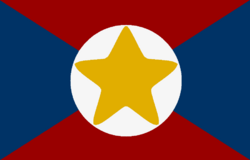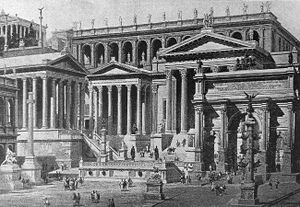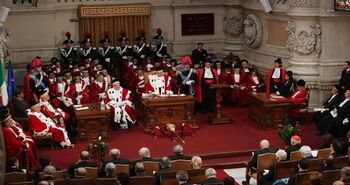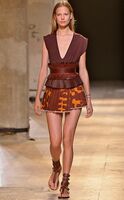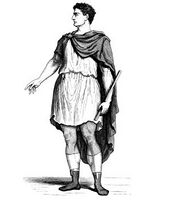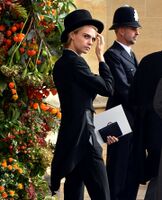Kouralia
| The Royal Union of Kouralia | |
| Flag of the Royal Union | |
| Anthem Heart of Red | |
| National Words Þeri Onore, Gyustysia ont Þe Curune | |
| Capital City | Kurton |
|---|---|
| Largest City | Chyricfriþyning |
| Ethnic group | Human 82.5% Fae 18.5% |
| Languages | English High Kouralian |
| Demonym | Kouralian |
| Governing Structure | |
| Bicameral Westminster-Style Constitutional Monarchy | |
| Queen | Alyxandra Campbell |
| Captain of Justiciars | Sir Barynel Caeryn |
| Justiciars' Court | |
| Noble Assembly | |
| Kouralian Senate | |
| Population | |
| Total (2015 Est.) | 1,079,000,000 |
| Increase | 0.6% per year |
| Total Area | 3,510,721 km2 |
| Population density | 307.3 per km2 |
| Date | dd/mm/yyyy |
| Dialing Code | +319 |
| Internet TLD | .Kour |
The Royal Union of Kouralia is a large nation located in the Northern Pony Lands (Alogoledas in High Kouralian), straddling the straits between the continents of Norstralia and Borealia. Like many nations within the Pony Lands and Mystria, it has supernatural elements to it, and both magicusers and non-humans are prevalent within its borders. Unlike most nations in the Pony Lands however, Kouralia is the only large human-majority power.
Kouralia is a federal constitutional monarchy ruled by both the Crown as head of state, and the Captain of Justiciars as head of government. While the Crown holds absolute Executive Power, its powers are delegated to different institutions to ensure that no one branch of government holds absolute power.
History
For many millennia the Kouralian Peninsula had been populated by human beings, fae and demi-fae. However, despite there being a multitude of states extant on the peninsula in its history, the only ones which are regarded as 'predecessors' to the Second Royal Union are those with the city of Kurton as its capital. Other states generally were originally subsumed as Imperial Provinces, before becoming part of Kouralia proper rather than seen as separate administrative districts.
The first example of a predecessor state to the current Second Royal Union of Kouralia is regarded as the republican City of Kurton which was founded in the 8th Century BCE, probably around 750 BCE. At the mouth of what is today the Reðuynyc River within the fertile Reðuynyc Valley, the City of Kurton was more-or-less protected from extreme outside aggression, and had sufficient abundance of resources to expand in magnificence. In the 4th century BCE a war between the City of Kurton and fellow neighbouring states of the Kouralian League Defense pact engaged in a 'civil war', predominantly to decide which between Kurton and the city of Rheðuyn would lead the league. In 338 BCE Kurtonian soldiers sacked Rheðuyn and the other states of the League were absorbed into the Kouralian Republic. Over the next 200 years the territory of the Republic expanded greatly and it rapidly became the foremost power in its area of the peninsula. In 120 BCE the rising power of the appointed high priest over the last two centuries saw the ostensibly Senate-appointed Oylacunin, or 'Noble King' of the Pagan Kouralian religion be de facto the absolute ruler of Kouralia.
This theocratic rule ceased after the Imerian Invasion in the 3rd Century CE when Sebastos Camhaoil, Commander of the Armies of the North, deposed the last Æðelcyning and became High King of Kurton.
As Kouralia expanded and the beliefs of its religion developed and experienced a reformation, conflicts occurred. Due to the close links between the Kouralian Church and the political power, the eventual schism resulted in a splitting of the Kouralian Empire into two nations by 1071: the Eastern Kingdom of Kurton and the Western Altonian Empire. Between 1200 and the 1680s the power of Kurton waned on in their Homelands, but grew in the Southern continent of Borealia where established trading settlements had grown to be provinces in their own right, and militantly expanded all the way to the borders of Discord's Realm in the South. In the late 18th century expansionist Kurtonian policy saw non-aligned nations within the Homelands becoming protectorates, puppet states, and finally provinces of the Kurtonian Empire while Altonia similarly conducted an attempt to prevent non-aligned states from being subsumed into Kurton's hegemony.
From 1790s to 1815 the invasion of Chieti by Altonia resulted in conflict between the two powers spilling out into open warfare, that concluded only with the surrender of Altonia and its absorption into the First Royal Union of Kouralia. Kurton (and then Kouralia) continued to become more and more Constitutional in terms of the authority wielded by the Crown until in 1963 when, following an incredibly deep recession the Chief of the Opposition in the Senate (and former Chief of Military Staff) launched a successful coup and deposed the monarch and lawful government. Immediately appointing himself temporarily 'August Father' of the nation to repurpose a historical republican title for the dictatorial commander-in-chief appointment in times of crisis, he established a faux-republican dictatorship while the surviving monarchists were either imprisoned and executed or fled to exile.
The Kouralian New Republic was destroyed following the Millenial War between 1998 and May 2001, resulting in the restoration of the monarchy in the new Second Royal Union of Kouralia and the execution of the new August Father: who was unsurprisingly a blood relative of the first August Father. First brought back as a summary measure, in 2002 the newly elected and empowered Senate voted to restore new constitutional authority to the Campbell family as monarchs and bearers of the Crown's Authority.
Due to the lack of enforced speciesist discrimination and sapient rights abuses since then, Kouralia has seen increased acceptance and involvement on the international stage.
Geography
Location
Kouralia is an immense nation with two main territories straddling both the continents of Norstralia to the North (Kouralia Proper) and Borealia to the South. They are separated by the Hobbiest Straits, which is a major waterway for seaborne traffic between Mystria and the Southern Pony Lands. On 'Kouralia Proper' is functionally a large peninsula which covers most of the Southern coast of the continent, and limits access to the Gulf of Ino. That of Kouralia on Borealia broadly separates the former Celestial Empire of Harmony to the East, known as Forynthry-Oryens in High Kouralian, and the remnants of the Hobbiest Republic Empire to the West (now Forynthry-Boreous). To the South is, among other nations, the wasteland formerly known as Montesardo-East Adanzi (now Forynthry-Auster), the hostile rogue state of the Realm of Discord, and Shrilland.
Due to its position, Kouralia claims de facto rights to the Gulf of Ino, aside from the territorial waters of, and international waters endeavours of other nations bordering the Gulf. It is extremely wary of and greatly opposes any attempts by foreign states to influence or operate within the Gulf of Ino. The Royal Union assumes a similar ownership of the waters surrounding the former Hobbiest Republic Empire, however this is primarily due to Kouralia's role in maintaining the secure perimeter surrounding the wilderness.
Climate and Terrain
Due to the size of Kouralia, its climate and terrain varies immensely. The islands and mainland approaching the North of the Homelands territory are very tropical alike the Caribbean. The land below there and to the West rapidly becomes a Mediterranean climate with green rocky mountains. Across the straits, the Borealian part of Kouralia generally has a temperate oceanic climate, though there are some Alpine areas (especially in the Mountains toward the South), and the hellscapes of Forynthry across the borders do tend to leak to an extent, and affect natural Kouralian flora and fauna in the Marches.
Administrative Divisions
Government
The Royal Union is a constitutional monarchy of the 'Westminster' style in which the royal family plays a major role in the running of the state as the physical embodiment of the Crown. As head of state the monarch of Kouralia is supported by a tripartite government consisting of the Executive, Legislature, and Judiciary.
Monarchy
See Also: Kouralian Crown, Royal Households of Kouralia
The Crown of Kouralia is, on paper, the authority for all legal governance in Kouralia. Nominally the Crown enjoys an 'aeternal ryte' to govern as 'foremost of those crowns within this land, now and forever.' The power is vested in the Crown, not the Monarch - the current personal bearer of the crown's authority - and certain Kouralian Statutes give power for state officials to remove the reigning monarch and replace them with the next appropriate person. Practically speaking most powers the crown holds are exercised by state officials, for example the Monarch's powers as the absolute arbitrating authority on criminal cases are handled by the Most Noble and Supreme Court of Kouralia while the royal prerogative of mercy is usually exercised on the advice of the appropriate Juticiar.
The exercise of some powers does require a personal undertaking by the monarch, though almost always this is at the behest of the relevant state official. Some are described below:
- The Monarch must declare war against any foreign sovereign state to provide the legal basis for any continuation of hostile military action against them beyond a given threshold set down in law. This is carried out on the recommendation of the Captain of Justiciars following a Senate vote.
- The Monarch must dissolve and reform the Senate following each general election, and must remove/approve the change of any senate seat incumbent mid-term (e.g. due to infirmity, resignation, criminality or other reasons). This power is exercised on the recommendation of the Captain of Justiciars when in general, or at the request of the Speaker of the Senate in individual cases.
- The Monarch must appoint a Captain of Justiciars who acts as Head of Government. This can only be a sitting member of the Senate or Noble Assembly for a period of 5 years at a time. Notionally it can be anyone who 'commands the respect of the [Senate]', however to cause them to do so it is inevitably the head of the majority political party/coalition appointed to this post.
Legislature
See Also: Senate of Kurton
Kouralia has a bicameral Legislature: the Lower House of which is the democratically elected Senate of Kurton and the Upper House of which is the appointed Noble Assembly. The Senate is considered to be supreme of all parts of the Kouralian Government, and is responsible for ensuring the bearer of the Crown is fit to continue to do so - exercising the authority of the Crown to choose its bearer in a way that the monarch cannot lawfully interfere with.
The Senate is filled with elected lawmakers known as Senators who are chosen by their constituents in national elections every five years. The number of seats, five hundred and fifty five is selected due to the sacredness of the number five in the Kouralian national religion. The first known mention to a Senate sitting in Kurton was in 749BCE as the ruling body of the Republic of Kurton.
The Upper House in the Kouralian Government is known as the Noble Assembly and its members are appointed by the Crown on advice from the Senate. All Princes of Kouralia hold seats within it, including Princes of the Blood. Furthermore the heads of a number of executive functions hold seats by virtue of their office, such as the 'Lords of War' who are the heads of the Kouralian Military. Finally, a number of foremost private individuals such as captains of industry, professionals, artists and charity advocates can be ennobled for life with a seat there. Such ennoblements are not hereditary.
Currently the Senate has a majority coalition of the Bonyas aþe’Coralyvienas and the Red Nationals Party, with the National Royalist Party leading the Opposition.
Executive
See Also: Kouralian Government, Crown Captain of Justiciars, Justiciars of Kouralia, Crown Adjutant Clerk Corps.
The Executive branch of government is responsible for enforcing laws and running the Kouralian state. It is headed by the Captain of Justiciars, assisted by a Cabinet of Justiciars who are the political heads of government Justiciaries. Members of the Cabinet are almost universally Senators or Assemblymen of the majority political party.
The Executive branch is assisted by the Crown Adjutant Clerk Corps (often known as the 'Secretariat') which consists of the professional staff responsible for implementing the policy decisions of the Cabinet. The Justiciaries themselves are assisted by 'Executive Agencies' which are a type of department lacking direct ministerial control, whether because of their insignificance or because it would be inappropriate to politicise.
Following the 2017 elections, the current government of Kouralia is the 2017 Cæryn Captaincy under Barynel Cæryn.
Judiciary
The Judiciary of Kouralia refers to the courts, and the judges and lawyers who work within them. In Kouralia these are referred to as 'Prætoriæ' or a singular 'Prætorium' rather than Courts or Court, and Judges are referred to as 'Prætors.' Its responsibility is to ensure that actions within the country are lawful - whether by striking down government policies for contravening the rights of citizens, or by hearing cases against individuals and groups and sentencing them in punishment for illegal actions.
| Criminal | Civil |
|---|---|
| The Crown Prætorium of Justice | |
| High Prætorium | |
| Provincial Appellate Prætorium | |
Centreðæl Prætorium
|
District Prætorium
|
Puisne Prætorium
|
|
Criminal cases start in Puisne Prætorium before a bench of Justices of the Peace who determine both guilt and sentence. Most offences are resolved here though some are escalated to a Centreðæl Prætorium, whether through severity or the Defendant electing the right to trial by peers. The Centreðæl Prætorium features a Centreðæl Praetors and a jury of Kouralian citizens who determine guilt. Appeals therefrom are heard by the Superior Courts.
The Superior Courts of the Provincial Appellate Prætoriæ, High Prætoriæ, and the Crown Prætorium of Justice hear cases in the absence of a Jury. They do not decide matters of fact, and instead decide if the inferior Prætoriæ have erred in either misadvising the Jury, applying an unduly harsh or lenient sentence or there is a failure to correctly apply the law. They instead have benches of senior Prætors and can either amend inferior judgements or order a retrial.
Local Government
Below the National Level, Kouralia has a number of geographic subdivisions which exercise delegated governmental authority. Provinces are federal in nature and exercise some ability to legislate and self-govern. They are headed by an elected Governor who has his or her own Cabinet, a Unicameral Provincial Assembly, and government departments, along with the Provincial Appellate Court. 'Local Authorities' are those below Provincial Level which are responsible for the provision of local government services (e.g. education, waste disposal, housing etc.) within a given area. There is a general delineation between different levels of governemnt as to which levels are responsible for which services.
| Unitary Authority | Metropolitan Authority | Non-Metropolitan Authority |
|---|---|---|
| National Level | ||
| Provincial Level | ||
Unitary District Level
|
||
Unitary District Level
|
Borough Level
|
Riding Level
|
| Ward Level | ||
At all levels of local government there exists an elected 'Council' which is usually supported by a permanent staff of assistants along with any local government agencies which carry out the services the council provides. Cities as divisions generally fall at the Borough or Ward level, and are granted City Status by the Governor or Royal City Status directly by the Crown. Cities are entitled to also elect or appoint a Mayor with varying levels of executive power depending on the Province, while Royal Cities may appoint or elect a Lord Mayor. Royal Cities are almost invariably Unitary Districts with strong levels of executive authority.
Armed Forces
See Also: Kouralian Armed Forces, Royal Kouralian Army, Kouralian Royal Navy, Kouralian National Air Force, Provincial Militia
The Kouralian Military is a venerable institution, tracing its lineage back to the Kurtonian Citadel Guard of the 8th Century BCE. It is divided into three services: the Royal Army (or Crown Host), Royal Navy (or Crown Fleet), and the National Air Force (or Air Fleet). These services are supported by the Provincial Militia (or Limitanei-Provincias), a secondary reserve force which primarily reports to the Provincial Governor but which can be called upon by central government to deploy alongside the regular military (then referred to as Pseudocomitatensian Cohorts). Due to the high social prestige placed upon military service, veterans are often lionised and military service is generally seen to be an important part of the course of offices through public life.
The Kouralian military is highly advanced, with modern technologies such as 5th generation aircraft, stealth technologies and unmanned technologies being used by all branches to great effect. The three services are regularly trained to conduct Joint Operations, and while it is impossible to prveent some element of service bias/blindness to the duties of other services, it has experienced great success in joint operations command. The Kouralian Army possesses both heavily mechanised forces for the defence of the homeland and for follow-up waves in expeditionary warfare, along with distinct lighter formations specialised for purposes such as mountain or jungle warfare, or airborne or amphibious commando operations. The Kouralian Navy doctrine focuses primarily on power projection from aircraft carriers, along with regular long-distance patrols of busy sea lanes and to interdict slavery. The Kouralian Air Force is responsible for provision of all fixed and rotary wing aircraft for both naval and land-based operations, including strategic operations and those in direct support of other services' operations.
Ongoing commitments include peace support operations in D'hɑlbrisir, and maintenance of the Forynthry Security Perimeters.
- Wiki Kouralian Army Soldiers.jpg
Kouralian soldiers wearing berets.
- Wiki Kouralian Helicopter Gunship.jpg
Kouralian Air Force Helicopter Gunship
- Wiki Offshore Patrol Vessels.jpg
Kouralian Offshore Patrol Vessels in Formation.
Justice
See Also: Law Enforcement in Kouralia, Kouralian Service Police
As a nation, Kouralia places the concepts of 'Justice' and 'Honour' very highly, and careers in associated professions are often regarded as more prestigious as in other nations. For this reason, the Justiciar for Public Safety is one of the senior-most government officials and exerts a lot of power within the nation. Kouralia is the founding nation of the international Coalition of Policial Networks (CoPNet).
Crime
Local crime is a continual fact of life in Kouralia, ranging from individual criminals to small gangs which are responsible for volume crime such as burglaries and dealing of drugs. This sort of criminality is dismissed by many members of society, and those who participate in it are often derided as thugs, and those who failed to make something more of themselves. There does tend to be a link with the more organised crime 'Firms', in that smaller local gangs will attempt to almost bid for contracts to carry out the low-level criminality on behalf of the Firm. Full, 'Blooded' membership of a Firm is no small deal, and the popular image of a cultured, honourable and affable 'gentleman gangster' is carefully cultivated and in most cases is the truth. There is an element of self-regulation in the major crime Firms which attempt to curb any excesses of violence to avoid drawing too much attention from the authorities and cutting into profits.
Common crimes include the smuggling and distribution of narcotics, firearms, and other prohibited items from foreign nations. This ranges from drugs and firearms from Allanea to corrupted artifacts from the Forynthry
Law Enforcement
Most law enforcement is carried out by watchmen serving in the territorial watches or 'Vygelas Astycus'. These territorial services are complemented by national organisations such as the Treasury Guard and Yronway Guard, and specialist squads of certain lead regional Watches. Their primary duties are the protection of life and property, preservation of the peace, and prevention and detection of criminal offences. All watch officers hold the Office of Constable, which gives them additional powers under law which are used to gather evidence of offences for presentation before a Prætor, or to keep the peace.
These organisations are supported by a multitude of Regulatory Inspectorates which have a limited law enforcement remit (for example, regulation of food and drug quality) but which can have their officers be given full law enforcement powers as 'Special Officers.' The most well-known of these is the Inspectorate of Revenue, Immigration, Customs and Excise who have responsibility for investigating offences relating to tax evasion and investigation of border offences. Other agencies exist which have much more limited scope of operations such as the Frontier Guards who have responsibility for border law inspection and enforcement, and the Crown Waterguard who have maritime interdiction responsibility.
Intelligence Services
See Also: Kouralian Intelligence Community
Oversight for National Intelligence gathering is now held by the Executive Intelligence Board which acts as a means of coordinating the actions and facilitating cooperation between all the intelligence agencies without having any actual operational control of them. The Executive Intelligence Board consists of the Directors-General of each Intelligence Agency along with political figures and senior Adjutant Clerks.
- Crown Intelligence Service - Director-General of Crown Intelligence
- Signals Intelligence Service - Director-General of Signals Intelligence
- Military Intelligence Service - Director-General of Military Intelligence
- Army Intelligence Corps - Commandant General, Army Intelligence Corps
- Naval Intelligence Branch - Superintending Admiral, Admiralty Intelligence Branch
- Air Intelligence Branch - Superintending Marischal, Air Marischalcy Intelligence Branch
The Intelligence Services do not have any official operational direct-action or overt capability as they are purely responsible for gathering and analysing information to produce workable and actionable intelligence in furtherance of the government's policy aims. Where action needs to be taken domestically it is through the Special Branch of the Treasury Guard or of other territorial watches to investigate or detain the subjects of intelligence, and in conflict zones abroad the military will carry out operations informed by the intelligence gathered. However, in situations where extreme discretion and deniability may be required, the Joint Intelligence Exploitation Regiment can be deployed abroad and at home to assist Intelligence operations.
Prisons
Each Province has its own Prison Service, referred to as a Vygelas Carceryas, however they are all held to identical standards and inspections are carried out by national government which also operates a national prison service for specialist, major, and high security establishments. There are varying types of Prisons, ranging from young offender training centres and Open Prisons which are more akin to a boarding school teaching skills necessary for rehabilitating offenders all the way up to 'Cat.(egory) A' Prisons which are functionally 'Maximum Security.' The decision about which category the offender will serve their sentence in is based on a combination of the type of crime committed, the length of sentence, the likelihood of escape, and the danger to the public if they were to escape.
Prisons have a great deal of autonomy about their running, though they must all comply with national guidelines and standards. The Governor of a Prison is tantamount to Captain of a ship and has final authority for matters of discipline, release, and staffing which are not required to be referred to a court. In this way parole boards are purely advisory.
Economy
The Kouralian economy overall has strong performance across all sectors of the economy, however the government has been criticised recently for allowing domestic production to slip in the face of imported materials. Kouralia produces many precision engineered goods domestically such as cars and other machinery, however traditionally high-tech goods such as computers, phones and digital products are often sourced from abroad. The Kouralian arms industry is one of the major exceptions to this rule, with advanced domestic-produced vehicles, munitions and weapons systems overwhelmingly supplying the Kouralian Military, and also being a strong export sector.
Agriculturally speaking Kouralia is a net importer of food, however the nation does produce enough of its food to not be fully reliant on foreign foodstuffs and recent initiatives such as the 'Starred Tractor' have seen a national shift toward 'eating Kouralian.' Kouralian fishing fleets are a thing, but fish consumption is not a major part of the diet of many Kouralians and the vast majority of seafood consumed in Kouralia is likely imported if not locally sourced. Metals and minerals are drawn from the ground in vast quantities though the growth of this sector has been stunted in recent years due to imports, however sourcing of certain goods such as the luxury Chiaræn Marble have continued strongly.
In terms of manufacturing, Kouralia produces many highly engineered goods such as machinery, defence technology, automobiles, and both water and aircraft. Marble-shaping and carving is also a sizeable industry in areas where marble quarrying is a major employer too. The manufacture of goods with a thaumical aspect to their construction is a growing trend in Kouralia and is expected to grow further with the government's initiatives to increase thaumical involvement at all stages of the education system.
In terms of the Service sector, Kouralia has a number of financial institutions, trading groups, and other service-providing companies. However, these have yet to significantly break onto the national market.
Many professions in Kouralia are represented by guilds which generally act as interest groups and guarantors of quality for their members but are not mandatory for a license to trade. There is no requirement that a company or practitioner join a guild, and many professions lack an appropriate guild, but generally most tend to join the relevant guild. Examples of guilds include the Free Companies' Guild and the Guild of Watchmen.
The currency of Kouralia is the Ryal, divided into 50 Crowns or 100 Half-Crowns. The ratio is currently 1 Ryal to 1.31 NSD.
Demographics
Kouralia is a large and populous nation with roughly 1.78 billion residents, of whom the vast majority are citizens (whether by birth or otherwise), but which also includes permanent and temporary residents and illegal immigrants. This is currently growing at a rate of 0.9% per year according to the average birth rates in the last four years although population growth rates in the future are projected to decline due to declining Fertility and immigration rates. Despite this, the population growth rate is expected to remain net positive for the foreseeable future as immigration rises limit the impact of declining fertility.
The overall life expectancy is 81 years, which is roughly an average amongst developed nations. In the most recent census, roughly 40% of the adult population of Kouralia defined itself as belonging to a group included under the LGBT+ umbrella.
Approximately 83.4% of the population lives in cities and urban areas as of 2018, with the majority of those living in cities with populations above 100,000. Population growth in cities remains high at over 1% per annum. This expansion in cities has resulted in the creation of several major conurbations such as the Chyricfriþyning Megalopolis. Overcrowding in cities has become an ongoing concern, encouraging the development of mass transit and more space and energy-efficient housing designs than the conventional Insula community model.
Largest cities or towns in Kouralia
2015 Census | |||||||||
|---|---|---|---|---|---|---|---|---|---|
| Rank | Province | Pop. | |||||||
 Chyricfriþyning  Boccaþ Ino |
1 | Chyricfriþyning | Provincia Aþe’Chyricfriþyning | 40,140,000 |  Melusine  Bedausworth | ||||
| 2 | Boccaþ Ino | Kurton Ost | 31,500,000 | ||||||
| 3 | Melusine | Leightonia | 27,200,000 | ||||||
| 4 | Bedausworth | Altonian Highlands | 26,540,000 | ||||||
| 5 | Afallon | Chieti Sud | 25,600,000 | ||||||
| 6 | Ceorlsby | Frontier of Civilisation | 25,000,000 | ||||||
| 7 | Niniannous | Altonian Highlands | 24,900,000 | ||||||
| 8 | Kurton | Reiprovincia | 24,100,000 | ||||||
| 9 | Decari | Centros | 23,900,000 | ||||||
| 10 | Niniannae | Niniannae | 23,876,000 | ||||||
Fei
See also: Feivienas
The so-called Feivienas (otherworldly-folk) of Kouralia are the second main species group extant in the nation after the human majority, making up roughly 20% of the population. They are made up of a wide ranging collection of sub-species which are possessed of magical affinity, and even inherent powers unique to their species. The correct term in Kouralia is regarded as 'Fei' (both singular and plural), or 'Feivien' and 'Feivienas' (singular, plural) in formal wording. Many of these sub-species have their own formal names along with colloquial names derived from the term 'Fei'; as an example, Kouralian werewolves are correctly termed Lvpan Selenes (the Moon's Wolves), however they can be identified as 'Fei-hounds', though many would find the term offensive. Throughout Kouralian history other terms have existed for these types, including 'elves', 'others' and 'otherkin', and 'the folk.' In the present day though, these terms have fallen by the way-side. Furthermore, while 'elf' can be used to describe Feivienas in some minor dialects of High Kouralian, it only refers to the Quendi of Menelmacar in mainstream usage.
Despite being separate species, the thaumical nature of their divergence from homosapiens means that reproduction is possible without barrier. This produces off-spring known as demi-fei who will regularly experience greater affinity with conscious magic usage, greater longevity, and often residual influence of that species of fei's inherent magical qualities. The degree to which this is experienced will often depend on the degree of separation from the original fei's influence on the human's bloodline. Research has been done as to why the degree to which one is 'demi-fei' does not conform to or reflect current understanding of genetics, but is inconclusive. As with the prevalence and probability of magic affinity within humans, the magical element makes it difficult for conventional science to pin down.
Language
Most Kouralians are at least bilingual, speaking both Common and the historic High Kouralian language. This is due to extensive globalisation policies from the Tyrannic era which forced multilingualism at both primary and secondary levels of education in Kouralia, resulting in the present day a very common-fluent population. Other languages including Equestrian are common, with some such as Necrontyr, Quenya and Malgravean becoming more common over the last decade.
Religion
See Also: Æhrycreda
The Æhrycreda is the national religion of Kouralia, and has been for millennia. Organised worship and following of the traditions of the faith are evident since the founding of Kurton and other settlements within the area, and references to the deities and primary concepts of the faith exist before the founding of the Kouralian Republic. Strictly-speaking the vast majority of Kouralians follow the Æhrycreda in some way or another, as it does not preclude the existence of other divinities. In fact, the Æhrycreda teaches that other divinities are a certainty, but focuses on the worship of those relevant to its own faith. The visible manifestations of the Æhrycredan Pentatheon in Kouralian life, such as in the 31st Annual Demon War, preclude consideration that the religion is false, and account for the low atheism rate in Kouralia. Only 12.7% in the last census recorded not 'duly venerating' the Æhrycredan Pentatheon, while 61|% of Kouralians worship them exclusively.
Education
Education is divided into 'Principal Education,' and 'Further Education' by the Kouralian Government. Principal Education is provided from age 5 to 16, and Further Education is from age 17 and beyond both by Colleges and Universities.
Culture
Social Class
See Also: Kouralian Honours, Palatine Principality of Rheðuyn
While a democracy, Kouralia's functioning constitutional monarchy comes with a predominantly ceremonial nobility. Notionally there exists a hereditary Principality that equates to each Province, and the holders of which are entitled to sit in the Noble Assembly. Hereditary Lordships often largely equate to counties, hundreds, boroughs or other local authority areas, though the boundaries will have changed over time, and there are only some authority areas which have their own hereditary lordship. In addition to this there are 'Civil Lords' who are ennobled for life by the crown at the recommendation of the Government. These tend to be people who have served the public extensively, often as a retirement package for figures such as Chiefs of Staff in the Military, Permanent Secretaries in the Adjutant Clerk Corps, Praetors, and major figures from the private sector for whom knighthoods do not fully represent their contributions to society.
In addition to the Nobility, there is a class referred to as the Celareas (singular, Celarean) or 'Knights.' These can be 'Knights Bachelor' who are knighted by the Crown without regard to a particular order, or members of a particular chivalric order such as the Order of the Citadel.
Fashion
While casual clothes such as jeans and casual shirts are common in every-day life, Kouralian fashion tends toward formal dressing of one of two styles. Regardless of the style worn, Kouralian attire is usually unisex whether it be tunics or trousers and shirts worn.
- The Classical Style, as the name suggests, harkens to a modern interpretation of clothing worn in the Classical period of Kouralian civilisation, around the commencement of the common era. Because of this it is considered equal parts old-fashioned and folky by many adherents of the Modernist Style. It generally entails dress-like, collarless tunics known as tunicas with smooth upper halves, but which often transition at the waist to an accordion pleat ending mid-thigh. When belted, the tail is tied off adjacent to the buckle and allowed to dangle off-centre.
For summerwear these are generally thin and breathable, and are liable to show more skin with higher hemlines and with sleeves and necklines which retreat into thin straps. These tunicas are worn with ankle-height sandals which allow wear of sheaths for the Caltaryæ Feraa. In colder climates, thicker material is used while boots and thick ankle socks perform a similar function regarding securing the knife sheaths. These can be hooded, and may be work with a coat or a cloak in inclement weather. Hats are rarely worn, however circlets are common. The tunica is often embroidered, and may feature design features to enhance their visual appeal. The Classical Style is noted for its comfort and light weight as it is a single garment with footwear.
- The Modernist Style originated from the development of modern, traditionally male foreign fashion. Accordingly it is considered a passing fad and distressingly conventional by adherents of the Classical Style. It consists of button-up shirts worn with jackets and trousers, sometimes with neckties and always with dress shoes. Belts are secured by loops on the trousers, and are universally of leather. This differs from the proclivity to use cinctures and cloth when cinching the waist on a tunica.
While akin to formalwear worldwide, the Kouralian Modernist Style is generally more colourful: even formally colours such as purple, green and red join traditional blues, greys and blacks. Shirts and neckties are also brightly coloured - with the former rarely being coloured pastel if they are not white. Shirts can be worn with and without a necktie, but will always feature a rigid fold-down collar of some description. They may be worn with a waistcoat or corset in a traditional three-piece suit, or more casually with a waistcoat or corset alone. Suits are common both casually and in business situations, whether with a traditional suit jacket or a more formal tailcoat or spencer. More casually blazers or sporting jackets are worn with contrasting trousers. It is common for the Caltaryæ Feraa to be sheathed under a trouser leg in this style. In colder weather either coats or a cloak can be worn, and hats of many descriptions are common. Shoes are commonly worn in the monkstrap style.
Spencer jacket worn as casualwear. Formal tailcoat worn with cummerbund and top hat. Chestnut monkstraps without broguing.
These styles will cross together, such as a recent proclivity to Purist fashionistas will generally adhere to one style or another and may regard cross-styling such as a Spencer with a tunica as sacrilege, most Kouralian wardrobes will feature a collection of outfits from either style as appropriate. Formal parties will often indicate on their invitations which style is desired. The Kouralian Military has adopted both styles for its uniforms. Principally Service and Dress uniforms are of the Modernist Style, however many more ceremonial units such as the Citadel Guard Regiment wear classical tunicas with military accoutrements such as aiguillettes, swords and even decorated and sculpted breastplates and helms.
Marriage and Æfenlytya
Kouralia does not have widespread marriage, with only roughly 30% of the adult population choosing to marry. This is because Kouralia has traditionally had two forms of bonding: marriage, and the institution of Æfenlytya or 'Companionship.' Throughout the formative early stages of the Æhrycreda it was held that legal sharing of property and titles and bonding of families and factions was of importance. Thus a marriage in Kouralia is a legal process whereby a contract of marriage is drawn up to give one's partner increased rights over joint property. However, the Æhrycreda teaches that love and lust, and acting on those forces is a force for good in the world and a way of venerating the gods. Thus, the religious institution of Æfenlytya was formed from a more structured way of regulating unmarried lovers.
While marriage is between a Husband and a Wife (or Husband and Husband/Wife and Wife), the state of Æfenlytya is between a number Æfenle (non gendered, pl: Æfenlas), which are given gender as the Æfenlo and Æfenla (pl: Æfenlas) for male and female respectively. The state of Æfenlytya is purely religious rather than administrative and is acquired and lost through a religious ceremony conducted by a priest of the Æhrycreda. It was only recently in 2002 that 'Æfenlytya' was recognised by statute as a marital status for forms, between 'Marriage' and 'Single': it does not automatically confer any enhanced legal rights to the person or property of one's Æfenle. Both marriage and Æfenlytya are permissible as of age 16, but Marriage requires the consent of a legal guardian until the age of 18.
The presence of such an informal institution of intimacy in Kouralian culture is often seen as a reason for its greater openness and acceptance of promiscuity and sexuality than in cultures which have a more socially reserved faith such as Christianity. In 2015 studies showed that while 30% of the adult population were married, 74.5% recorded a state of Æfenlytya, including 29.7% of the 30% of the population which was married. This included 1.4% of the population in polyamorous relationships (i.e. an Æfenlytya with more than one person) however that does not count all individuals in the statistic: only each individual who is registered with more than one Æfenlytya.
Cuisine
Kouralian cuisine focuses on the idea of a single hearty main meal to the day which is cooked traditionally overflows with meat and side dishes. This can be consumed as breakfast, or at lunch or tea-time, where that will be termed 'dinner.' This traditional dinner will consist of a main dish of meat, which is supported by a side dish of vegetables and a possible side dish of starchy food such as bread or pasta. After this follows a sweet dish. Alcohol, generally wine, is consumed throughout that meal.
Traditionally the most common meat in Kouralia is pork, including gammon, bacon, ham, and in sausages. Beef, venison, veal, lamb, mutton, and game are also common, as is poultry. Fish is less so, unless close to the coast or in the North of the country. Lauryba is one of the national dishes of Kouralia and consists of dried cured meat, consumed as a snack. This can be of any meat but is commonly pork, beef or game. Another national dish is Testaroli, a pancake-like sheet made with chestnut flour which is cooked upon a skillet before being sliced into small squares or triangles and then prepared as if it were pasta. This is served with many
Meals which are not the 'Dinner' of the day will usually be smaller, and are often cold finger food such as salads and sandwiches.
Eating establishments can generally be divided into three categories. A restaurant is generally higher class and for the consumption of food. Eating is always at a table, and food is more expensive and there is a focus on the aesthetic of a dish. A tavern is less formal and generally focuses greatly on the consumption of alcohol - to the degree that most will have separate 'restaurant' and 'bar' areas where people can sit and eat, and stand or sit and drink. A Bar is a smaller establishment which is generally for the consumption of alcoholic or non-alcoholic beverages, and foodstuffs that can be eaten on the go.
Sports
Kouralia as a nation has a number of sports, and its national sport is denoted by law. Association Football is a common ballgame, however the msot followed sports are combat sports ranging from empty-handed events such as wrestling through to one-on-one swordsmanship and group 'battles.' The official sport of Kouralia is a combination wrestling and boxing event termed the Omniperio which is renowned for its violence and lack of rules. Flat-hand combat events generally feature matches of periods, and can be won through technical superiority and scoring of moves, or through simple knock-outs. Striking combat events such as boxing are common and different events will vary in terms of which zones may be struck and struck with, weight classes, and protection.
There are also a number of combat events involving weapons ranging from quarterstaff fighting through to swordsmanship with and without shields. Another sport is team-based combat which varies in terms of rules, weapons, and discipline requirements. The most common of these involves teams of armoured fighters attempting to defend and seize a crest from the opposing team's captain, and return it to their captain.
Public Holidays
Kouralia has a number of public holidays or Feryæ which are observed due to tradition and which typically result in a day or multiple days off of work along with other traditions. These occur throughout the year and have been formalised by the National Holiday Act 2013, which provides for which holidays necessitate either double pay for working, or a day off. The Kouralian calendar does not correspond to the Gregorian Calendar directly, however most Kouralians use the Gregorian calendar for business purposes, and it is only for the placement of certain holidays that the Kouralian calendar is used. Where one of these holidays falls on a weekend, the next following working day is pronounced to be a public holiday.
- On the day of the Hibernal Solstice and the day after, Kouralians celebrate the Yearsend by handing out presents and getting royally drunk. While it is slightly off the Gregorian 'New Year', it is used in lieu of this ceremony, and no public holiday is approved on the 1st of January or on the 25th of December whose festivals are mirrored by this celebration.
- On the 15th of March the Feryæ Salyæ is celebrated, to commemorate the concepts of Honour and truthfulness, and Justice and law. It is traditional on this day for the royal prerogative of mercy to be used ceremonially by both the Crown and each Provincial Governor to commute the sentence of a prisoner. The selection of which prisoner is to be freed for this ceremony is rigorous, and if none can be found who it is suitable to free, then a ceremonial faux prisoner is released.
- The Glorious 25th of May is a celebration of the restoration of the Monarchy to Kouralia and the end of the Millenial War in 2001.
- On the Estival Solstice and the day after, Kouralians celebrate the Demiferyæ or Half Festival, which marks half way through the year. This is generally celebrated with public parties in parks and streets which are subsudised and organised by local authorities: though road-obstructing street parties have been clamped-down on recently due to interference with emergency responses.
- On the 13th of September the Festival of the Fallen commemorates those of the Watches, Military, and civilian who have otherwise fallen in the pursuit of Honour, Justice, and Freedom.
- On the 14th of September the Feryæ aþe'Probatyo Vygelas celebrates the Kouralian Military and Guards, and is an occasion for military parades throughout many cities.
- On the 31st of October the Feryæ aþ'Amburbyum celebrates the purification of communities of evil and dishonour through public processions and rituals in the day, and at night the wearing of costume and partaking in communal games to represent the early return of dishonour: a remnant of a reminder to be ever-vigilant about evil.
- At some point throughout the year each Province is authorised to hold its own Provincial Day as a public holiday, though these are generally taken to be paid-double within that Province for inter-provincial business (e.g. a call-centre) rather than for days off to be taken, except, for example, for local retail work.
